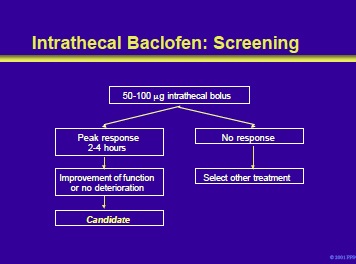Page 4 of 8

Patients who meet the criteria for ITB should be screened by the algorithm shown on the slide. Screening consists of the administration of a bolus of intrathecal baclofen by lumbar puncture or spinal catheter. Most patients will respond to the initial dose of 50 mg. A response consists of a significant reduction in spasticity, usually within 30 minutes to 1 hour, and peaking at 2 to 4 hours. In those who do not respond to the initial bolus, a trial with 75 mg or 100 mg is the next step.
During this process, patients should be monitored carefully for any signs of a drug overdose or other adverse effects. Failure to respond to a dose £100 mg indicates that the patient is not a candidate for intrathecal baclofen.
References
- Albright AL. Intrathecal baclofen in cerebral palsy movement disorders. J Child Neurol 1996;11(Suppl 1):S29-S35.
- Becker R, Alberti O, Bauer BL, et al. Continuous intrathecal baclofen infusion in severe spasticity after traumatic or hypoxic brain injury. J Neurol 1997;240:160-6.
- Coffey RJ, Cahill D, Steers W, et al, for the United States Intrathecal Baclofen Study Group. Intrathecal baclofen for intractable spasticity of spinal origin: results of a long-term multicenter study. J Neurosurg 1993;78:226-32.
- Ordia JI, Fisher E, Asamski E, et al. Chronic intrathecal delivery of baclofen by a programmable pump forfor the treatment of severe spasticity. J Neurosurg 1996;85:452-7.
Add comment